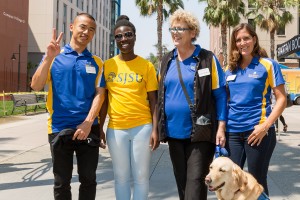
Photo by David Schmitz
Faculty members Wilson Yuan, far left, Carolyn Glogoski, center right, and Cristina Tortora, far right, pose for a photo with a student on Move-In Day in August. They are part of the Faculty-In-Residence program this year.
When some San Jose State students arrived with family and friends for Move-In Day on Aug. 20 and 21, they learned their next door neighbor in the residence hall might not be a new student, but a faculty member.
A collaboration between Academic Affairs and Student Affairs, the new Faculty-In-Residence program launched this fall with nine faculty members who will live in the halls, eat meals with students and plan activities to help them acclimate to university life. The program is one of many initiatives in SJSU’s Four Pillars of Student Success plan that is focused on improving student engagement and advising. The faculty members, who are provided with housing to forge connections with students outside the classroom, will be planning activities and working with students about 10 hours a week.
Carolyn Glogoski, an associate professor in the College of Applied Sciences and Arts Occupational Therapy department, said she was looking forward to connecting with first-year students through the program. A 27-year veteran at SJSU, she said she was a first-generation student from a working class background which allows her to relate to many SJSU students.
“Transitions are so difficult so we want to look to see if we can develop connections that will help them to seek support,” she said. “Professors can seem intimidating and students have to do more on their own in college. It’s so very different from high school.”
As part of the pilot program, the faculty members will be working closely with housing staff, specifically resident advisors and residential life coordinators, to develop activities throughout the semester to engage students.
Cristina Tortora, a new faculty member in the College of Science Mathematics and Statistics department, said she had already connected with some students who were interested in starting a running club.
“I enjoy living at the university,” she said. “I am new as well so I will get to know the students and the campus.”
She was especially interested in connecting with international students as she herself comes from Europe by way of Canada.
“If they have an issue, I hope they will be comfortable coming to me,” she said.
Steven Del Chiaro, a lecturer in the College of Social Sciences Psychology department, said his career in higher education started in housing and the Faculty-In-Residence program will allow him to have one foot in Student Affairs while still teaching.
His area of focus in psychology is student development and career development.
“The stereotype of faculty is that they are unapproachable and they should be revered,” he said. “We can help to put more of a human face on the faculty, get students more engaged in class and help students find their own strengths.”
The team of Faculty-In-Residence sent surveys to students to see what types of activities they most want to see with a goal of creating a mix of social, educational and recreational programming. The faculty members also plan to develop assessment tools to determine which activities are most successful during the pilot year so the program can be improved next year.
“The biggest challenge will be having students get used to having a faculty member around,” Del Chiaro said.
Both Glogoski and Del Chiaro have the ultimate ice breaker – they both have a dog living with them in the residence halls that draws the attention of the students. Glogoski’s yellow Labrador Cammie is a trained service dog while Del Chiaro’s Boerboel/Ridgeback mix Chiana is a therapy dog, both whom occasionally visit classes with their owners as a teaching tool.
“During Welcome Day while students were moving in, they were so excited that Cammie would be in the dorms with them,” Glogoski said. “And parents were pleasantly surprised that we (faculty) would be in the dorms, too.”